How can you summarise a reasonably accurate overview of the history of the island of Ireland in just one short article? It’s impossible – I know. But I’ll try anyway…
Page Contents (click line to jump the text)
Intro
The history of the island of Ireland is very turbulent and very eventful. It wants to be told.
And if you’re a bit interested in Ireland and its history, like I am, then you’ll want to know something about it.
But where to start? The Irish are originally Celtic, aren’t they? What does this have to do with the Vikings or Normans and why are there so many parallels to English culture today, even though the Irish are independent? And is Ireland a modern state today?
Many questions – and what about the answers? They are deeply rooted in the history of the island!
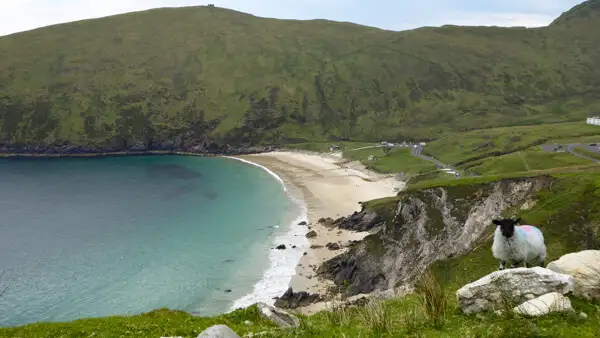
It was only when I wrote down a timeline of important events that a lot of things became clearer to me. I would like to give you an overview of Irish history over time in this article today.
In subsequent articles, we will take a closer look at some of these events or eras.
Small disclaimer: I am not a historian and, despite serious research, accept no liability for errors, misunderstandings, riots or revolutions of any kind….
Early History
Mesolithic period (ca. 8000-4000 BC)
After the last ice age, hunter-gatherers colonise Ireland. They leave behind the first archaeological traces such as stone tools. It is not completely clear where these first settlers came from.
Neolithic period (approx. 4000-2500 BC)
Agriculture and animal husbandry are introduced and large megalithic tombs such as Newgrange are built, but smaller stone circles and portal tombs also date from this period. See also my article on the Drombeg Stone Circle: https://ireland-insider.com/drombeg-stone-circle-the-megalithic-heritage-of-ireland/, or the Poulbnabrone Dolmen on the Burren: https://ireland-insider.com/the-rocky-burren-a-very-special-landscape-in-ireland/.
This period marks the beginning of sedentary communities. It is thought that these people sailed along the coast in small boats and brought the first livestock to the island. See also my article on the Ceide Fields: https://ireland-insider.com/the-ceide-fields-long-before-the-celts/.
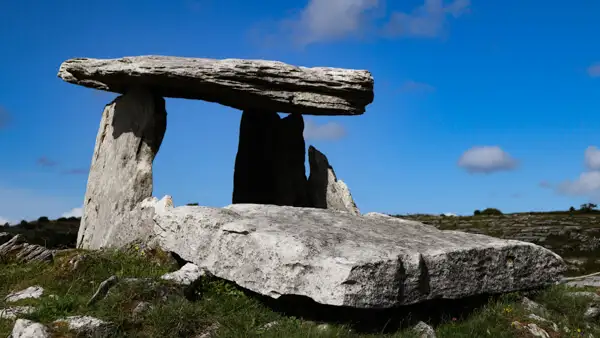
Copper Age (ca. 2500-2200 BC) and Bronze Age (ca. 2500-800 BC)
The early Irish began to extract copper and process it into tools. This period forms the transition to the Bronze Age, in which the manufacture of weapons and jewellery made of bronze predominates.
Arrival of the Celts (ca. 500 BC)
The Celts establish Gaelic societies, with clans and chieftains. Their mythology and social structure characterise Ireland until the Middle Ages. The Celts are experienced warriors and also bring the knowledge of working the harder iron to the island.
They could build better weapons and tools than the ‘indigenous population’ of the island and were also better organised. They took over the island of Ireland without any problems and it is assumed that the indigenous population was absorbed into Celtic society, i.e. integrated. There were several Celtic tribes, from which the Gaels migrated to Ireland. Today’s ‘Irish’ goes back to the original ‘Gaelic’, i.e. the Gaelic language of the Celtic Irish.
Early contacts with Rome (ca. 100-300 AD)
Trade relations with the Roman Empire lead to a limited cultural exchange. However, there is no Roman conquest. The Romans have more than enough to do in England with the resistance of the Picts and later also with the Saxons invading England. The Roman Empire found its last fortified border in the north of England, at Hadrian’s Wall, which finally fell with the collapse of the Roman Empire. Incidentally, the Picts are also a Celtic tribe, distantly related to the Gaelic Celts of Ireland.
The Early Christian Era
Introduction of Christianity (approx. 400 AD)
St Patrick missionises Ireland and introduces Christianity. It replaces the Celtic religion and soon becomes predominant.
Foundation of monasteries (5th-6th century)
Monasteries such as Clonmacnoise and Glendalough become spiritual and cultural centres. They preserve the knowledge of antiquity and promote art and Christian education.
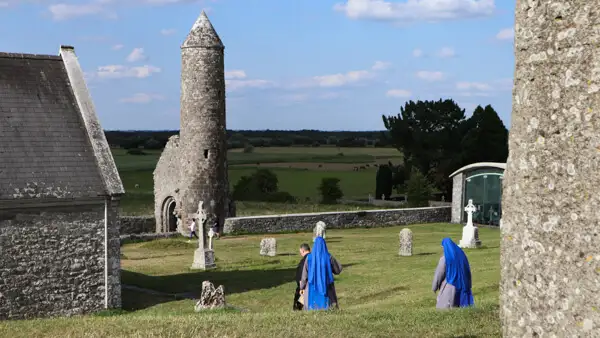
Irish monasteries produced artistic, ecclesiastical artefacts that were exported to England and, in some cases, to the European continent. Read also my article on the monastery of Clonmacnoise: https://ireland-insider.com/clonmacnoise-monastic-site-a-treasure-at-the-river-shannon/.
Ireland’s Golden Era (6th-8th century)
Irish missionaries such as Columban spread Christianity in Europe. Important manuscripts such as the Book of Kells are created. Ireland becomes the Christian university of Europe. The sons of noble families from all over Europe are educated at important monasteries, such as Glendalough. See also my article on the monastery of Glendalough: https://ireland-insider.com/glendalough-monastic-city-a-top-attraction-in-irelands-ancient-east/.
The Era of the Vikings
First Viking raids (795 AD)
After the first raids in England and Scotland, the Vikings also learnt about the valuable artefacts in Irish monasteries. The first documented raids by Nordic Vikings took place in 795. The Vikings plundered Irish monasteries and captured valuable treasures. Their raids marked a new phase of insecurity. You can also read this article on the Vikings: https://ireland-insider.com/vikings-a-tour-in-the-footsteps-of-the-hit-series-and-the-viking-heritage-of-ireland/.
Founding of Viking settlements (9th century)
Vikings establish cities such as Dublin and Limerick as trading centres and towns. Incidentally, the Vikings ruled and governed the greater Dublin area for around 200 years, they settled permanently and also mixed with the Gaelic population, as modern genetic analyses can still determine today.
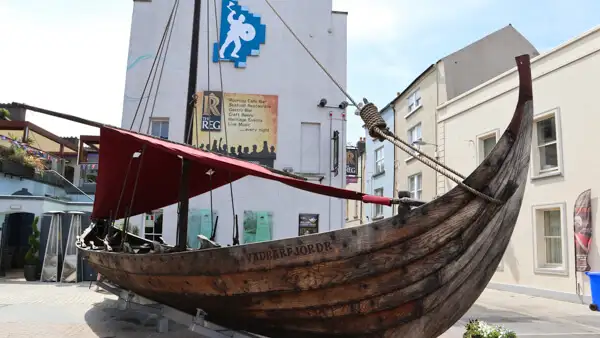
These places later became important cultural centres. They also founded Wexford, Waterford and several trading centres, especially on the southern coasts of the island. Read my article on Waterford, which is still particularly proud of its Viking past: https://ireland-insider.com/waterford-and-the-vikings/.
Battle of Clontarf (1014)
The Irish High King Brian Boru defeats the Vikings and their allies. The Vikings lose influence, but their settlements remain.
The Norman Conquest
Norman invasion (1169)
Norman knights, led by Richard Strongbow, land in Ireland. They support local rulers, but quickly take control. The Normans originate from Normandy in France and already dominate England and Scotland at this time, which is why they are also known as Anglo-Normans. In Ireland, they establish themselves as the greatest power before the Vikings and the Gaelic clans.
Appointment of Henry II as Lord of Ireland (1171)
Henry II of England establishes direct English rule over Ireland. This lays the foundation for the long Anglo-Norman and later English dominance. To consolidate Anglo-Norman supremacy, massive and magnificent Norman castles are built all over the island of Ireland, the ruins of which still characterise the landscape today.
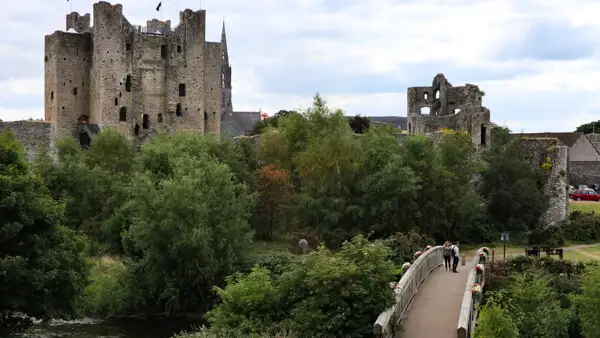
Read also my articles on the mighty Trim Castle: https://ireland-insider.com/trim-castle-the-biggest-norman-castle-in-ireland/, or on the legendary Blarney Castle: https://ireland-insider.com/blarney-castle-and-the-stone-of-eloquence/.
Rise and fall of the Gaelic principalities (13th-15th centuries)
The Normans displace the Irish lords in many areas. From the 15th century, however, the Irish clans regained influence. This is also due to the fact that the successors of Henry II, namely Henry III and Edward I, are more interested in England, Wales and Scotland and less in Ireland and support their own people in Ireland less and less.
The Renaissance and Reformation
Irish Renaissance (15th century)
Gaelic culture experiences a heyday with poetic and musical masterpieces. While Edward de Bruce fights the English (Anglo-Normans) in Scotland and later seeks refuge in Ireland, resistance to the occupiers also develops in the ranks of the Gaelic clans. Several conflicts later, the influence of the Norman occupiers waned and, abandoned by England, they even allied themselves with the Irish clans and adhered to the Catholic faith even during the Reformation that later emanated from England. This is the ‘Gaelisation’ of the Anglo-Normans in Ireland.
Reformation and Anglicanism (16th century) and the Nine Years’ War (1594-1603)
The English kings introduce Protestantism to Ireland. This causes tensions with the predominantly Catholic population. Irish lords such as Hugh O’Neill fight against English supremacy. The war ends with the defeat of the Irish and the flight of their leaders.
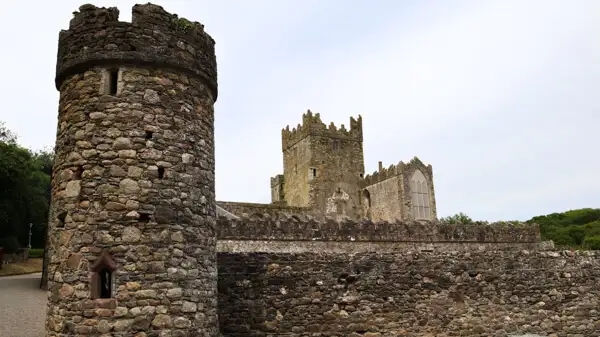
A little anecdote: The Catholic bishop Miler McGrath visited Elizabeth I in England and she, pragmatically and to the chagrin of the Vatican in Rome, made him a Protestant bishop – so he could keep his episcopal see at Cashel. Read here my article on the Rock of Cashel: https://ireland-insider.com/the-legendary-rock-of-cashel/.
Plantation of Ulster (1609)
In order to get the rebellious Irish clans under better control, the English crown decides to settle English and Scottish Protestants loyal to England in north-east Ireland (County Ulster). This changes the ethnic and religious composition of the region and lays the foundations for the future Republic of Northern Ireland.
Early modern period
Irish Confederate Wars (1641-1653) and the conquest of Ireland by Cromwell (1649-1653)
Catholic Irish rebel against English Protestants. The conflict ends with the brutal conquest by Oliver Cromwell, an English nobleman who lands in Ireland in 1649 on behalf of the English crown with a powerful army to put down the uprisings.
He brings modern cannons with him and shoots holes in the castles of the Irish clan chiefs until they gradually give up their resistance. Read my article on the beautiful Cahir Castle: https://ireland-insider.com/cahir-castle-a-star-among-the-castles/.
Cromwell’s troops subjugate Ireland with extreme rigour. Land is confiscated and the Catholic population is suppressed.
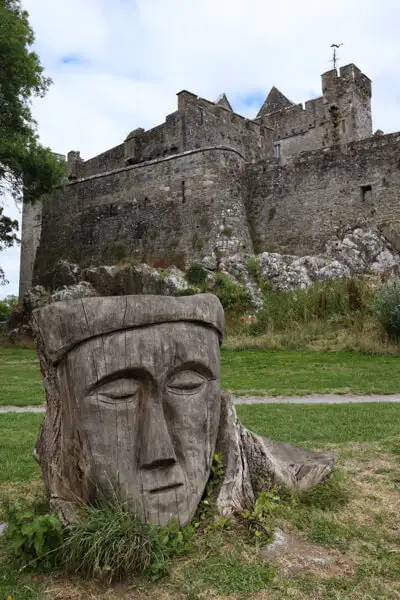
Jacobite Wars and the Battle of the Boyne (1690)
In England, the Catholic King Jacob II had antagonised many of his Protestant lords and parts of the population and was eventually forced into exile in France. The throne was taken over by William of Orange.
Both sides had their supporters and fought for years in England, Scotland and also in Catholic Ireland for the English crown. In 1690, William’s army defeated James II’s troops on the River Boyne, consolidating Protestant supremacy for a long time. See also my article on Drogheda on the River Boyne: https://ireland-insider.com/drogheda-things-to-see-and-do/.
Penal Laws (18th century) and Irish Enlightenment (18th century)
During English Protestant domination, Catholics and non-Anglicans were increasingly discriminated against, which severely restricted their political and economic power. Catholics are no longer allowed to hold political office or practise law. During this time, Catholics were also prohibited from owning land.
The estates were essentially taken over by Protestant English lords and Catholics worked as tenant farmers on land that no longer belonged to them. There were exceptions, but that was the trend of the time. Economic growth and cultural prosperity reached cities like Dublin. Nevertheless, many Irish people remained poor and disenfranchised.
The 19. Century
Irish Rebellion of 1798 and the Union with Great Britain (1801)
The United Irishmen demand independence. The rebellion is brutally suppressed. Ireland officially becomes part of the United Kingdom. The Irish Parliament is dissolved. See also my article on the rebellious town of Enniscorthy: https://ireland-insider.com/the-rebellious-town-of-enniscorthy/.
Catholic Emancipation (1829) and the Great Famine (1845-1852)
Catholics regain the right to hold political office. This initially puts an end to some discrimination.
In the middle of the 19th century, a potato blight devastates the country for several years (The Great Famine). The potato is the staple food of the rural Irish population, who suffer terribly in a famine that lasts several years and kills millions. Many Irish emigrate, particularly to the USA and Canada, but also to Australia and New Zealand.
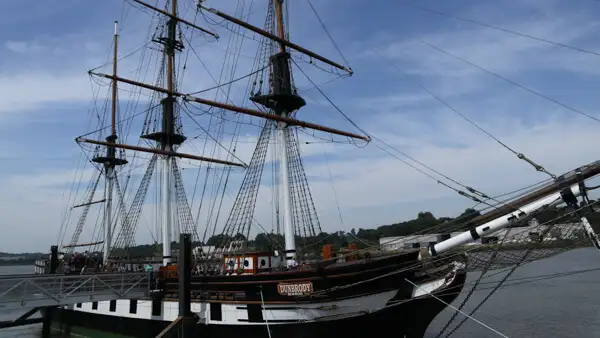
The population of Ireland is decimated during this time and only recovers very slowly afterwards. See also my articles on the Dunbrody Famine Ship in New Ross here: https://ireland-insider.com/wexford-so-old-so-new/, and here: https://ireland-insider.com/a-historical-round-trip-in-irelands-ancient-east/.
Irish Land Wars (1870s-1880s) and Celtic Revival (late 19th century)
Irish farmers fight against high rents. Land reforms are implemented.
Interest in Irish culture, language and history grows again. The Irish Literary Revival is born. See also my article on Irish poets and writers: https://ireland-insider.com/poets-and-writers-in-dublin-the-literary-heritage-of-ireland/.
The 20. Century
Easter Rising (1916) and Irish War of Independence (1919-1921)
An armed uprising in Dublin demands independence. It fails, but inspires the later revolution, which is mainly supported by the rural population and the labour movement. The ‘Old’ IRA (not to be confused with the IRA in the much later Northern Ireland conflict) wages a guerrilla war against the British.
The Irish counties vote to remain part of the Commonwealth, which ultimately leads to the partition of Ireland. Six Protestant-dominated counties in the north-east (see Uster Plantation) vote to remain and later form the Republic of Northern Ireland. The remaining counties of Ireland vote in favour of secession and become an autonomous Free State in 1922.
Irish Civil War (1922-1923) and the establishment of the Republic of Ireland (1949)
Pro- and anti-Treaty forces fight over the future of the Free State. The conflict ends with a victory for the pro-Treaty side. Ireland finally declares itself a sovereign republic with the name Éire and officially withdraws from the Commonwealth in 1949. The British, weary of war after the Second World War, finally allow the ever-rebellious Irish to become independent without further military conflict. Read also: https://ireland-insider.com/is-ireland-part-of-great-britain/.
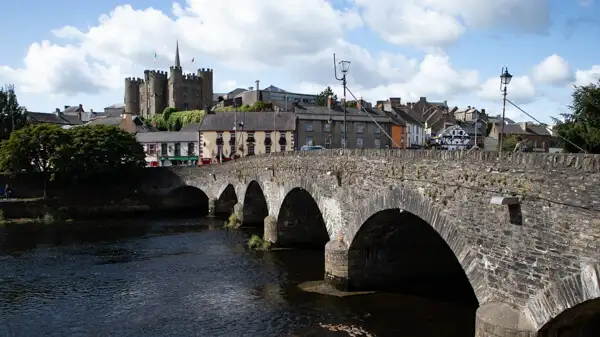
Northern Ireland conflict (‘The Troubles’, 1960s-1998) and the Good Friday Agreement (1998)
In the 20th century, conflicts between English and Scottish Protestants and Irish Catholics in Northern Ireland escalate. Violence between unionists and nationalists characterises Northern Ireland for many years. Bomb attacks and military intervention from England dominate the news.
‘Bloody Sunday’ in Derry-Londonderry ends particularly tragically. A peace agreement ends the conflict. Northern Ireland remains British, but gains autonomy. See also my article on Londonderry-Derry: https://ireland-insider.com/a-walk-on-the-city-walls-of-derry-londonderry/.
The 21. Century
Economic boom (‘Celtic Tiger’, 1990s-2008) and financial crisis (2008-2013)
Ireland’s economy is growing rapidly, especially in the technology sector. This is mainly due to the Irish government’s clever industrial policy, which focuses on promoting modern technologies and industries such as green energy, information technology and IT, medical technology, biotechnology and pharmaceuticals.
However, in the growth frenzy, there is little control over the granting of loans, which leads to rampant and speculative construction activity in the private and commercial property sectors. When many jobs were cut during the economic crisis and many people lost their jobs, the overheated property market collapsed and Ireland needed international aid.
Modern democracy today
It is fascinating that Catholic (and one would think, Vatican-loyal) Ireland, of all countries, decided to legalise gay marriage in 2015. This makes it the first country in Europe to legalise gay marriage by referendum.
A referendum in 2018 also lifts the ban on abortion, a milestone in social policy.
The United Kingdom’s withdrawal from the EU (Brexit 2016-2020) creates years of uncertainty for Irish-British relations.
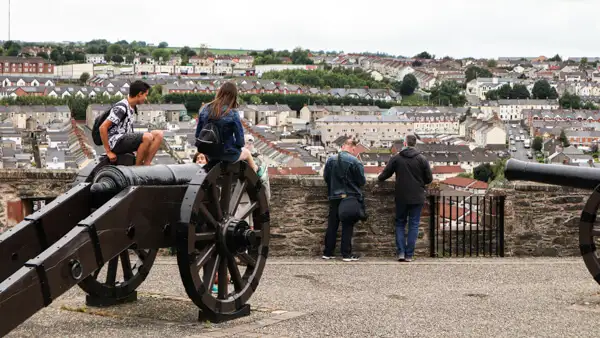
Ireland, and Dublin in particular, is establishing itself as Europe’s Silicon Valley and is becoming an influential player in the EU, especially in the field of digitalisation, not least thanks to the arrival of American software companies. However, the massive tax breaks with which Ireland has lured American tech giants to Ireland have been heavily criticised by the EU. Incidentally, Ireland has been a member of the EU since 1973.
With the invasion of the Russian army in Ukraine, a discussion is also beginning on the ‘seemingly remote’ Emerald Isle in the Atlantic as to whether the minimal Irish armed forces should be increased and perhaps seek NATO membership.

Conclusion
Let’s get back to my questions in the intro and a few answers that are already becoming clear: The first settlers on the island of Ireland are little known, but the Celts came to the island later. Then came the Vikings, then the Normans, then the English – and all of them left their mark on the genetics of today’s Irish!
But the Irish are not just a genetic mixture of immigrant ethnic groups, they have also carried their genes into the world with the mass emigration of later centuries: to the USA and Canada, to Australia and New Zealand and to many other countries around the world.
And despite all this immigration and emigration, they have managed to define, celebrate and value their cultural heritage. Today, despite their Catholic traditions, they are a very modern, European, democratic state. They have not lost themselves in the maelstrom of global migration, but have preserved and even rediscovered their traditions.
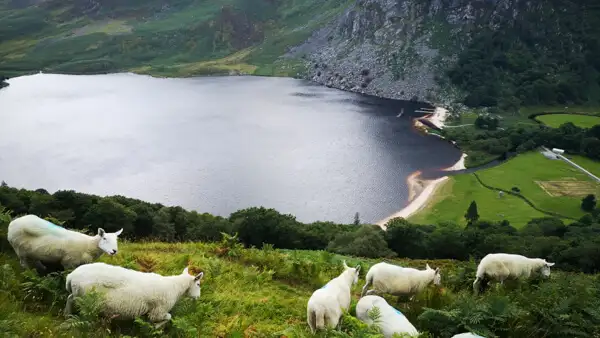
The island is still divided, but having grown up in a divided and later reunited Germany myself, I could imagine that there will be an Irish reunification at some point…? We’ll see…
Now I have attempted the impossible and given you an overview of Irish history in just one article – I hope you found it interesting.
More interesting articles for you
The City of Belfast – things to see and do
Frequently asked Questions and Answers about Dublin
ORGANISING A HOLIDAY TRIP TO IRELAND – THESE PRACTICAL TIPS WILL HELP YOU!
Ireland Travel FAQ
Cover picture: Sailing ship Dunbrody in New Ross harbour (Photo: Ulrich Knüppel-Gertberg, https://irland-insider.de, https://ireland-insider.com)